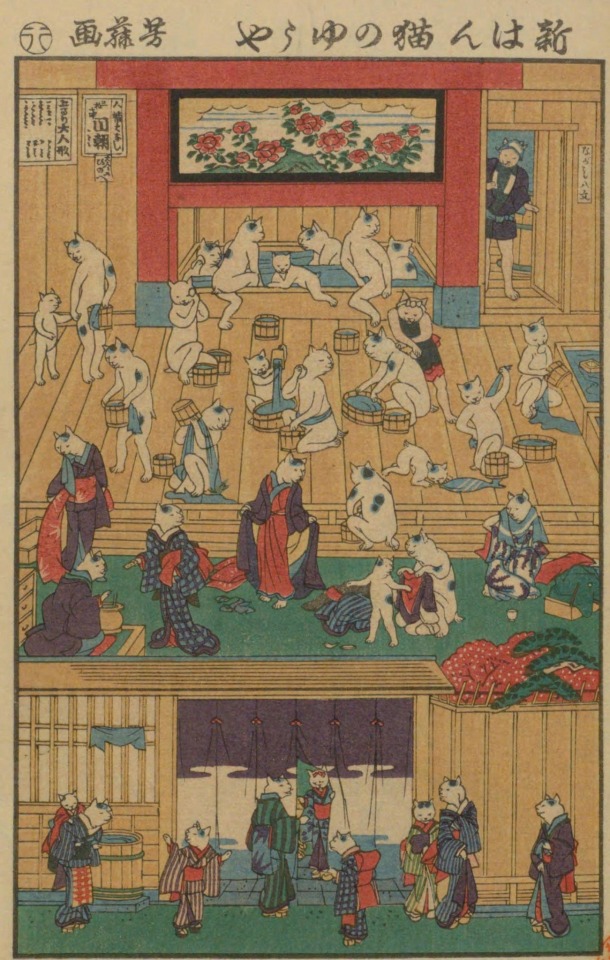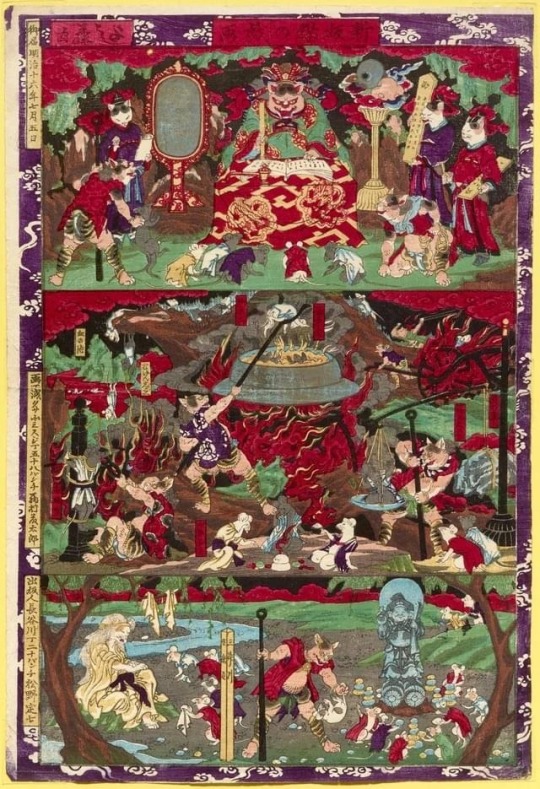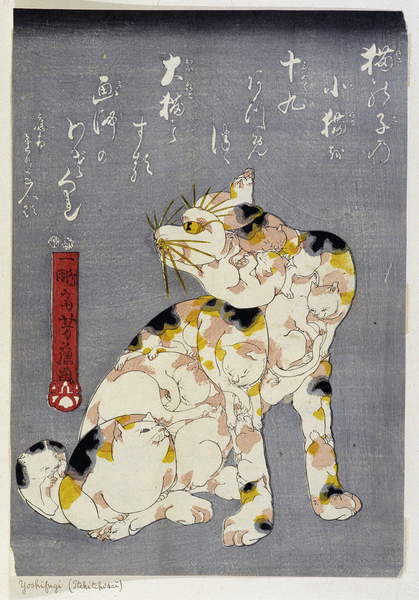#Utagawa Yoshifuji
Explore tagged Tumblr posts
Text

歌川芳藤 UTAGAWA Yoshifuji (1828-1887)
「新板 猫の温泉」
504 notes
·
View notes
Text

Attribution: Utagawa Yoshifuji 歌川芳藤, real name Nishimura Tōtarō 西村藤太郎 (Japan, 1828-1887). Woodblock print, omocha-e 玩具絵, (toy print, meant for children). This one has admirable cats. Thanks to @paulalupkin for the tip.
#omocha-e#woodblock print#ukiyoe#omochae#toy print#National diet library#japanese prints#cat#gato#illustration#katze#chat#kat#neko#feline#cats in art#animals in art#anthropomorphic animals#yoshifuji#utagawa yoshifuji#芳藤
24 notes
·
View notes
Text
For #ILoveHorsesDay ❤️🐴:

Utagawa Yoshifuji (Japan, 1828–1887)
Assorted Horses, 1855
Color woodblock toy print (Omocha-e)
British Museum 1915,0823,0.388
(photo © The Trustees of the British Museum CC BY-NC-SA 4.0)
#animals in art#animal holiday#19th century art#Japanese art#East Asian art#Asian art#horse#horses#I Love Horses Day#print#woodblock print#ukiyoe#omocha-e#Utagawa Yoshifuji#British Museum#toy print#domesticated animals
43 notes
·
View notes
Text

Utagawa Yoshifuji - Newly Published Comic Picture of Cats (Shinpan neko no giga) (1883) :: Japan :: Meiji era (1868-1912), 1883 (Meiji 16), July 5 Woodblock print (nishiki-e); ink and color on paper:: H. 145/8 x W. 913/16 in. (37.2 x 25 cm)
Susan L. and C. J. Peters
In this depiction of judgment, punishment, and salvation, Utagawa Yoshifuji casts mice as the judged and condemned and cats in the role of judges, torturers, and Datsueba (the Hag of Hell). Only one figure appears in human form, the blue savior at the lower right. Normally this individual would be Jizo (the bodhisattva Kshitigarbha), but in this satirical print he is Daitokuten, a folk god of good fortune and prosperity, who had a cult following during this period. The cats punish the mice in the same ways that humans are punished in Buddhist hell paintings, including being dunked into boiling cauldrons or blood pools.]
[Guillaume Gris]
* * * *
THREE A.M.
The god of three a.m. is the god of the dripping faucet, sirens, and barking dogs. He’s been given titular charge of circumstances that cannot be controlled. “It’s out of my hands,” he says, repeatedly. He is a minor functionary, a troll that lives under a bridge. On the far side are the pastures of night where bright stars graze in the dark matter of the cosmos. He is fond of philosophic thought. “Of course, our understanding is limited. All we can do is adhere to those laws and principles that have been proven, time and again, to work.” It seems there is some discrepancy in my papers. “A minor delay,” he assures me. Now it’s almost four.
LOUIS JENKINS
[alive on all channels]
#catoriess#Utagawa Yoshifuji#Japanese art#stories#Buddhist#Guillaume Gris#poem#poetry#Three A.M.#Louis Jenkins#alive on all channels
10 notes
·
View notes
Photo

Unbekanntes Bild von Utagawa Yoshifuji (Undatiert, Estampe)
#kunst#artwork#art#kunstwerk#utagawa yoshifuji#asian art#asiatische kunst#animals#tiere#cats#katzen#kalligraphie#callygraphy
7 notes
·
View notes
Photo
One, cat doll dress up. Two, double sided paper dolls. So cool!

Utagawa Yoshifuji
Cat paper dolls.
Very few of these prints survived because their purpose was to be cut up by children to play with.
572 notes
·
View notes
Text

Saw this on the dash (disabled reblogs, so I won't tag them) and its fine but just thought I would note its a bit off.
Anthropomorphized ukiyo-e predated the Tenpo Reforms, but it wasn't common and the general outline here is correct - but it wasn't a cat-specific trend (The book this quote is from is just from "What's Michael?" a cat manga). Here is Utagawa Yoshifuji's “Sumō Wrestling of Rabbits":

Here is Utagawa Kuniyoshi's "Yoshiwara Sparrow’s Temporary Nest":

And people did enjoy the parodic aspects, so it continued - you can find prints up through the 1870's - but it wasn't that popular, human depictions once they were permitted again became 99% of the market in short order.
Also the Tenpo Reforms weren't really repealed? What they are referring to is the firing & exile of Mizuno Tadakuni, the initiator of the reforms who was the only one who really cared about enforcing the artistic censorship part of the policies, so after that no one bothered with the letter of the decree. But the Tenpo Reforms were wide ranging and primarily about economics & financing; big parts of those failed by 1843, while other parts continued and were never really repealed, just built upon. Again I get it, its not like the Shogunate had a congress or a perfectly codified legal system, but I do think "after the removal of Mizuno Tadakuni the laws were no longer enforced" would be a better way of saying this.
120 notes
·
View notes
Photo

Yoshifuji Utagawa's “Shinita Nekojin Ryomengo”.
384 notes
·
View notes
Text

Artist Yoshifuji Utagawa 1828-1887
Title Kanadehon Chushingura - 47 Ronin - Act 11
Description
"Kanadehon Chushingura" Act.11. Ronins found their arch enemy Kono Moronao in a coal shack.
12 notes
·
View notes
Text

歌川芳藤 UTAGAWA Yoshifuji (1828-1887)
「志ん板 猫のあきんどづくし」
73 notes
·
View notes
Text

Utagawa Kuniyoshi ,'The Habit of Reading Books'..."Utagawa Kuniyoshi (Japanese: 歌川 国芳, [ɯtaɡawa kɯɲiꜜjoɕi]; 1 January 1798 – 14 April 1861) was one of the last great masters of the Japanese ukiyo-e style of woodblock prints and painting. He was a member of the Utagawa school. The range of Kuniyoshi's subjects included many genres: landscapes, women, Kabuki actors, cats, and mythical animals. He is known for depictions of the battles of legendary samurai heroes. His artwork incorporated aspects of Western representation in landscape painting and caricature...
Kuniyoshi was an excellent teacher and had numerous pupils who continued his branch of the Utagawa school. Among the most notable were Yoshitoshi, Yoshitora, Yoshiiku, Yoshikazu, Yoshitsuya, and Yoshifuji. Typically his students began an apprenticeship in which they worked primarily on musha-e in a style similar to that of their master. As they became established as independent artists, many went on to develop highly innovative styles of their own. His most important student was Yoshitoshi, who is now regarded as the "last master" of the Japanese woodblock print. Among those influenced by Kuniyoshi was Toyohara Chikanobu.[7] Takashi Murakami credits the pioneering influence of Kuniyoshi affecting his work.
3 notes
·
View notes
Photo

Newly Published Comic Picture of Cats by Utagawa Yoshifuji (1883)
#utagawa yoshifuji#art#ukiyo-e#woodblock prints#fine art#19th century#19th century art#meiji period#meiji era#woodblock print#japanese art#japanese artist#japanese folklore#japan#japanese#cats#hell#asian art#classic art
377 notes
·
View notes
Text

TOY ZUKUSHI (1958) by Utagawa Yoshifuji.
434 notes
·
View notes
Photo

Utagawa Yoshifuji (Japanese, 1828–1887)
Newly Published Applications for Cats, ca. 1868–1912.
36 notes
·
View notes

